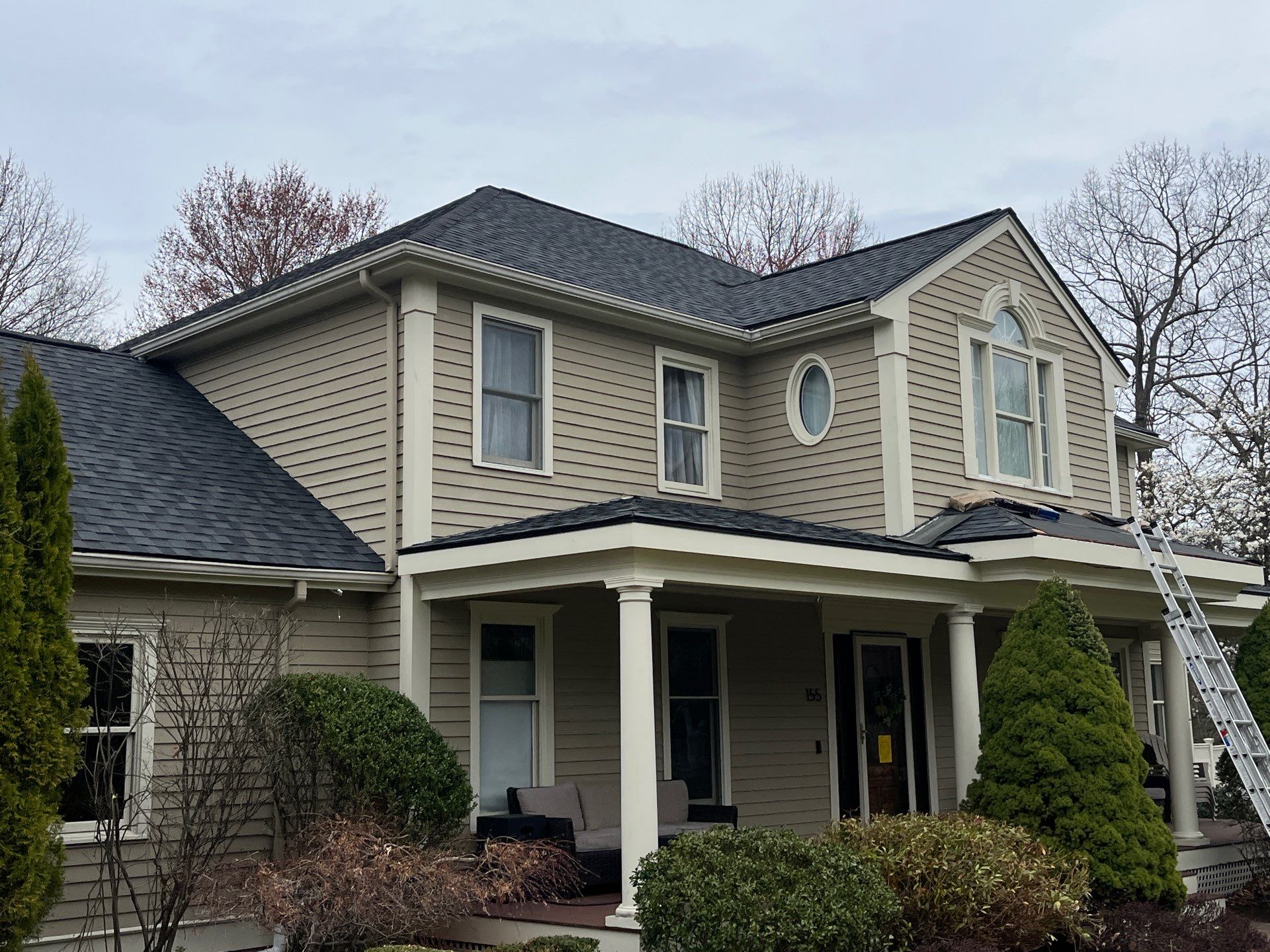
How to Install Rubber Roofing | DIY EPDM Guide
EPDM rubber roofing is a highly durable and effective solution for low-slope and flat roofs, offering excellent protection against the elements for decades. While the concept of rubber roofing might seem straightforward, its installation is a meticulous process that demands precision and attention to detail to ensure a watertight and long-lasting result. This guide provides an overview of the steps involved in installing EPDM roofing. However, Masterpiece Roofing highly advises that due to the critical nature of proper sealing and flashing, this is a job best left to experienced roofing professionals.
What you’ll need: Tools and materials
Attempting an EPDM installation requires a specific set of tools and materials. Ensure you have everything ready before beginning:
Materials:
EPDM Membrane: Ordered in large sheets, sized to minimize seams. Available in various thicknesses.
EPDM Bonding Adhesive: Specifically formulated for EPDM, often solvent-based or water-based.
EPDM Primer: For cleaning and preparing seam areas and flashing.
Seam Tape/Splice Tape: For creating watertight seams between membrane sheets.
Flashing Tape/Cured Coverstrip: For sealing details around penetrations and edges.
Lap Sealant: A liquid sealant applied over seam edges for added protection.
Termination Bar (optional): Metal bar used to mechanically fasten the membrane at perimeters.
Fasteners/Plates (for mechanically fastened systems): Screws and plates to secure the membrane.
Insulation/Recovery Board (optional but recommended): To create a smooth surface and improve R-value.
EPDM Caulk: For minor seals and finishing details.
Wood/Plywood (for curb construction): If building a new curb for edge termination or skylights.
Tools:
Tape Measure: For precise cutting and layout.
Utility Knife and Heavy-Duty Blades: For cutting the EPDM membrane.
Seam Roller: A hard roller used to apply pressure to seam tapes for proper adhesion.
Roller or Paintbrush: For applying bonding adhesive and primer.
Brooms/Leaf Blower: For cleaning the roof surface.
Drill/Screwdriver: For fasteners and termination bars.
Pressure Washer (for surface prep): If cleaning a dirty substrate.
Safety Gear: Gloves, safety glasses, knee pads, non-slip shoes, and fall protection harness (essential for roof work).
Surface preparation before installation
Thorough surface preparation is the most critical step in EPDM roofing installation. Any imperfections, debris, or moisture on the substrate can compromise the adhesion and integrity of the membrane.
Remove Old Roofing: In most cases, existing roofing material should be completely removed down to the deck. This allows for a clean, stable surface and inspection of the underlying structure.
Clean the Deck: Sweep and clean the roof deck meticulously. Remove all dirt, dust, debris, sharp objects, nails, and fasteners. A power wash may be necessary for existing surfaces, followed by complete drying.
Inspect and Repair the Deck: Examine the roof deck (plywood, concrete, etc.) for any signs of rot, water damage, unevenness, or loose sections. Repair or replace any damaged decking. The surface must be sound, smooth, and dry.
Install Insulation/Recovery Board (Recommended): For optimal performance, energy efficiency, and a smooth substrate, install rigid insulation or a recovery board over the deck. This helps prevent imperfections from "telegraphing" through the EPDM and provides a stable surface for adhesion.
Address Protrusions: Ensure all vents, pipes, skylights, and other penetrations are properly secured and prepared for flashing.
Ensure Proper Drainage: Confirm that the roof deck has adequate slope to allow water to drain effectively to gutters or drains. Address any low spots where water might pond.
EPDM roofing installation steps
Once the surface is perfectly prepared, the EPDM installation can begin. Always refer to the specific manufacturer's instructions for the products you are using, as details may vary.
Measuring and cutting the membrane
Layout the Sheets: Unroll the EPDM membrane loosely over the prepared roof surface. Allow it to relax for at least 30 minutes (or longer in cooler temperatures) to minimize wrinkles and shrinkage.
Position for Minimal Seams: Position the sheets to cover the roof with as few seams as possible. Overlap sheets by at least 3-6 inches (refer to manufacturer guidelines) where seams will be made.
Cut to Size: Using a utility knife with a sharp blade, carefully cut the membrane to fit the roof dimensions, allowing for adequate overhang at the edges (typically 3-6 inches) to wrap down over the perimeter. For penetrations (pipes, vents), cut slightly smaller pilot holes and then refine them later for flashing.
Applying adhesive correctly
(Assuming a fully adhered system, which is common)
Fold Back the Membrane: Fold back approximately half of an EPDM sheet to expose the substrate and the underside of the membrane.
Apply Bonding Adhesive: Apply the EPDM bonding adhesive evenly to both the exposed roof deck and the underside of the folded-back membrane. Use a roller or paintbrush. Ensure complete, uniform coverage, especially near edges. Avoid puddling.
Allow Flash-Off Time: This is critical. Allow the adhesive to "flash off" or become tacky to the touch (usually 10-20 minutes, depending on ambient temperature and humidity) before mating the surfaces. It should not be wet.
Roll the Membrane: Carefully roll the EPDM membrane back into place, pressing it firmly into the tacky adhesive. Work from the center outwards, using a broom or roller to smooth out any air bubbles or wrinkles. Repeat for the other half of the membrane sheet.
Repeat for Subsequent Sheets: Continue this process for all remaining EPDM sheets, ensuring proper overlap for future seams.
Sealing edges and seams
This is the most critical phase for waterproofing and requires meticulous attention.
Clean Seam Areas: Once the membrane is adhered, meticulously clean all seam areas (where two sheets overlap) using EPDM primer or a designated cleaning solution. This removes any contaminants and prepares the surface for tape adhesion.
Apply Seam Tape: Apply the EPDM seam tape (often 3 inches wide) centered over the pre-primed seam. Press it down firmly, then use a specialized seam roller with significant downward pressure to ensure complete, wrinkle-free adhesion of the tape to both membrane sheets. This mechanically bonds the sheets.
Lap Sealant: Apply a continuous bead of liquid EPDM lap sealant along the entire outer edge of all seams. This provides an additional layer of waterproofing and seals any potential pinholes.
Edge Termination: At the roof perimeter, the EPDM membrane should extend beyond the edge. It can be wrapped down over the fascia and secured with a termination bar, or adhered to a specially constructed wood curb, and then sealed.
Flashing Penetrations: For pipes, vents, and other penetrations, specialized EPDM accessories (e.g., pipe boots, flashing patches) are used. These are adhered and sealed meticulously around the base of the penetration to ensure watertightness. Skylights require specific curb and flashing details.
Common installation mistakes to avoid
DIY EPDM installation can lead to costly mistakes if not executed perfectly. Here are the most common pitfalls:
Inadequate Surface Preparation: Leaving debris, moisture, or unevenness on the deck will cause adhesion failure, bubbles, or punctures.
Insufficient Adhesion: Not applying enough adhesive, applying it unevenly, or not allowing proper "flash-off" time will result in poor bonding, leading to bubbling and membrane delamination.
Poor Seam Work: The majority of EPDM roof leaks originate at seams. Improper cleaning, insufficient pressure with the seam roller, or skipping lap sealant will lead to catastrophic leaks.
Improper Flashing: Detailing around pipes, vents, and edges is complex. Errors here are a primary source of water intrusion.
Ignoring Manufacturer's Instructions: Every EPDM system has specific guidelines for adhesives, primers, and tapes. Deviating from these can void warranties and lead to failure.
Working in Poor Weather: Installing EPDM in rain, excessive cold, or extreme heat can negatively impact adhesive performance and membrane flexibility.
Membrane Damage: Accidental punctures or cuts during installation can be difficult to spot and repair effectively.
Incorrect Slope: If the underlying roof does not have adequate slope, water will pond, stressing the membrane and leading to premature wear.
When to call a professional roofer
While this guide outlines the steps, the complexities and critical nature of EPDM installation make it a project best suited for certified roofing professionals.
Masterpiece Roofing offers:
Expertise and Experience: Our crews have extensive training and hands-on experience with EPDM systems, understanding the nuances of surface preparation, adhesive application, and, most importantly, flawless seam and flashing execution.
Specialized Tools and Materials: We use commercial-grade tools and ensure the correct, compatible EPDM products are used for your specific roof.
Safety: Working on roofs, especially low-slope ones, carries inherent risks. Our professionals adhere to strict safety protocols, protecting themselves and your property.
Warranty Compliance: Professional installation ensures that your EPDM membrane and associated products are installed according to manufacturer specifications, preserving your valuable product warranties.
Peace of Mind: With Masterpiece Roofing, you gain the confidence that your EPDM roof will be installed correctly, providing a durable, watertight, and long-lasting barrier for your property. We handle all the complexities, from permits to cleanup.
Don't gamble with the integrity of your flat roof. For a reliable and expertly installed EPDM roofing system, trust Masterpiece Roofing. Contact us today for a comprehensive consultation and a detailed estimate.
Office: 1248 Highland St, Holliston, 01746 MA
(508) 882-6080
Email: office@buttonmasterpieceroof.com
Site: www.masterpieceroof.com
Assistance Hours
Mon – Fri 8:00am – 4:00pm

